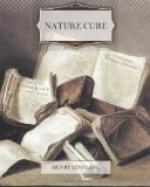On the other hand, the homeopathic physician may use the same remedies as the allopath, provided they produce symptoms similar to those of the disease, but he administers the different drugs in such minute doses that their first effect is noticed only as a slight “homeopathic aggravation,” while their second and lasting effect is relied upon to relieve and cure the disease.
In other words, homeopathy produces as the first effect the condition like the disease, and counts on the second and lasting effect of the drug to bring about a permanent change.
If, in accordance with the Law of Dual Effect as applied to drugs, the primary, temporary effect of the homeopathic remedy is equal to the disease, it is self-evident that the secondary, lasting effect of the remedy must be equal to the cure.
This law has been proved by homeopathy for over a hundred years. An experienced homeopathic prescriber would no more doubt it than he would doubt the Law of Gravitation.
Homeopathy and the Law of Crises
Therefore, if the remedy be well chosen in accord with the Law of similia similibus curantur, the first homeopathic aggravation, which corresponds to the crisis of Nature Cure, will be followed by speedy and perfect readjustment. Nature has her way, the disorder runs its course, and the return to normal conditions will be quicker and more perfect than if the homeopathic remedy had not been employed or if Nature’s healing processes had been forcibly interrupted and suppressed by large, poisonous allopathic doses. Homeopathy assists Nature in removing the old encumbrances, whereas allopathy changes the acute, inflammatory healing effort into chronic, destructive disease.
The Economics of Homeopathy
The Law of like cures like is of great practical importance from another point of view, namely, that of economics.
The best engineer is the one who accomplishes the maximum of results with the minimum of expenditure of force and with the least friction. The same is true of the physician and his remedies.
We have learned that drugs given in the coarse allopathic doses attack and affect the organism as a whole. If, for instance, there is a catarrhal affection of the serous and mucous membranes of the respiratory tract accompanied by fever, the allopath will give quinine in large doses to change this condition. He may accomplish his aim; but if so, he does it by paralyzing the heart, the respiratory centers, the red and white blood corpuscles and the excreting cells of the mucous membranes. The body as a whole and certain parts in particular are saturated with the drug poison and correspondingly weakened. As allopathy itself states it: “Quinine reduces fever by depressing the metabolism” (the vital functions).
Homeopathic materia medica teaches that Bryonia has a special affinity for the mucous and serous membranes of the respiratory tract and that its symptomatic effects correspond closely to those described in the preceding paragraph.




